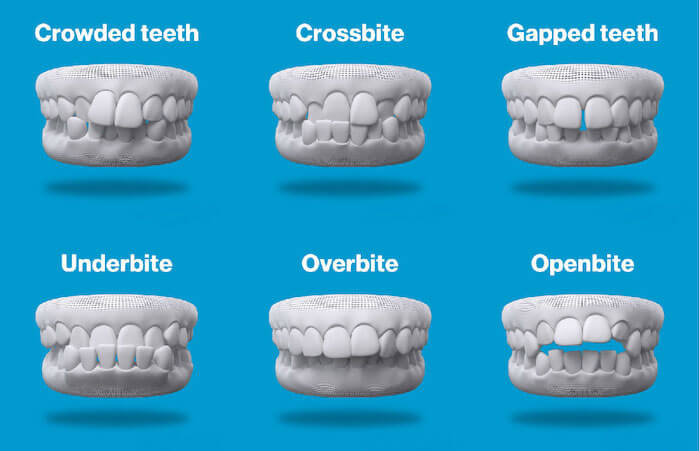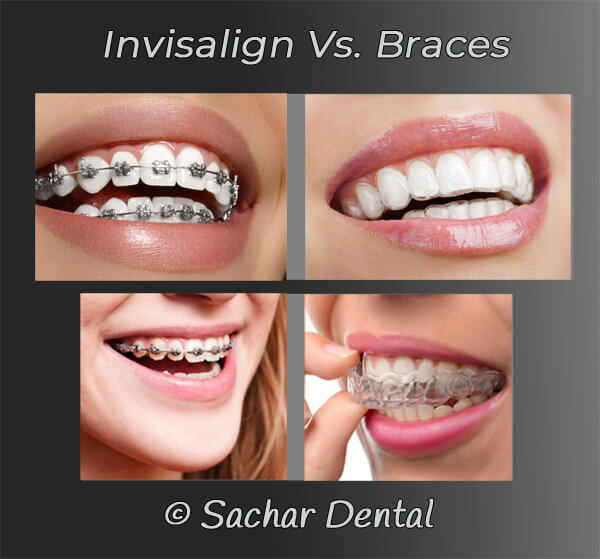Invisalign for Teens: A Modern Solution to Straightening Young Smiles
Invisalign for Teens: A Modern Solution to Straightening Young Smiles
Blog Article
Invisalign vs. Conventional Dental braces: Which Option Is Right for You?
When considering orthodontic treatment, the choice in between Invisalign and typical braces presents a number of crucial factors that warrant mindful assessment. Invisalign offers a discreet alternative with detachable aligners, while standard braces offer an extra visible yet reliable option for extreme imbalance.
Overview of Treatment Choices

On the other hand, typical braces contain steel brackets and wires that are bound to the teeth. This method applies continuous stress gradually to achieve positioning. While effective for intricate orthodontic concerns, standard braces call for regular check outs for adjustments and can posture difficulties in preserving dental health as a result of the trouble of cleaning about brackets and cables.
Both choices have their benefits, and the selection often depends upon particular dental conditions, way of life choices, and patient conformity. Eventually, getting in touch with an orthodontic professional is vital for figuring out one of the most suitable treatment strategy customized to private requirements. Comprehending the nuances of each choice can dramatically influence the general success of orthodontic treatment.
Aesthetic Considerations
A significant factor affecting the option between Invisalign and typical braces is the aesthetic allure each treatment supplies. Invisalign aligners are crafted from clear plastic, making them virtually unseen when worn.
On the other hand, standard braces are composed of steel brackets and cords, which can be more recognizable. While advancements in orthodontic modern technology have brought about the development of smaller sized braces and colored elastics, standard dental braces still maintain an even more obvious profile. For some individuals, the visibility of braces may deter them from seeking essential therapy.
Ultimately, the option between Invisalign and standard dental braces may rest on personal preferences concerning aesthetics. Individuals that focus on discernment commonly favor Invisalign, while those that are much less concerned about exposure may choose standard dental braces. Understanding the visual ramifications of each choice is essential for making an informed decision that lines up with one's way of living and preferences.
Convenience and Convenience

In terms of benefit, Invisalign aligners are removable, enabling patients to enjoy their preferred foods without constraint and maintain optimal dental health. Brushing and flossing are streamlined, as the aligners can be taken out during these regimens, whereas conventional braces call for cautious navigating around braces and cables.
In comparison, traditional braces require routine adjustments, making them much less practical for those with hectic timetables. Generally, the comfort and convenience of Invisalign make it an enticing option for lots of individuals seeking orthodontic treatment.
Therapy Duration and Performance
While both Invisalign and typical braces are efficient in remedying oral imbalances, the duration of therapy can differ substantially in between both options. Typically, Invisalign treatment can take anywhere from 12 to 18 months, relying on the complexity of the case. The clear aligners work by slowly shifting teeth into their wanted placements, and regular follow-ups with an orthodontist aid guarantee progress remains on course.
In contrast, traditional braces commonly need a longer commitment, generally varying from 18 months to 3 years. This is due to their set nature and the usage of braces and cables, which can be extra reliable for severe misalignments and complex cases (Invisalign). The treatment effectiveness of typical dental braces is well-documented, as more they enable specific adjustments and higher control over tooth movement
Ultimately, the choice in between Invisalign and standard braces might pivot on both the anticipated treatment period and the certain oral issues available. Consulting with an orthodontist is vital, as they can give tailored recommendations based upon individual requirements, ensuring the chosen approach aligns with wanted end results and timeframes.
Expense Contrast and Insurance Coverage Options
Expense plays a significant role in the decision-making procedure for individuals taking into consideration orthodontic therapy, whether selecting Invisalign or typical braces. Typically, the expense of Invisalign ranges from $3,000 to $8,000, while conventional dental braces generally set you back between $2,000 and $6,000. Variables influencing these costs consist of the complexity of the case, the duration of treatment, and geographical place.
Insurance policy insurance coverage can substantially impact out-of-pocket expenses. Many oral insurance policy strategies supply partial insurance coverage for orthodontic therapies, however the specifics can vary extensively. It is crucial for patients to evaluate their insurance plan to determine the level of protection for either option. Generally, conventional dental braces may be more frequently covered by insurance strategies compared to Invisalign, which some insurance providers classify as a cosmetic procedure.
In addition, a number of orthodontic practices offer flexible payment strategies, making both therapy alternatives a lot more accessible. Patients need to ask about prospective funding alternatives and discount rates for in advance settlements. Evaluating the total cost, consisting of insurance policy advantages and settlement strategies, is crucial for making an educated choice that straightens with both aesthetic choices and budget plan factors to consider.

Conclusion
In recap, the option between Invisalign and typical dental braces rests on numerous factors, consisting of visual choices, comfort, therapy period, and cost. Invisalign provides a discreet, detachable alternative that facilitates oral hygiene and nutritional flexibility, while traditional dental braces might find more info be more suitable for intricate oral issues and commonly come with a reduced rate factor. Inevitably, appointment with an orthodontist is vital to assess private scenarios and identify the most ideal therapy choice for accomplishing optimal oral alignment.
When taking into consideration orthodontic treatment, the option in between Invisalign and typical dental braces provides a number of essential factors that merit careful analysis.Comparing Invisalign and conventional braces discloses unique therapy options for orthodontic adjustment.While both Invisalign and typical dental braces are reliable in dealing with oral misalignments, the period of therapy can vary considerably between the 2 choices.Price plays a significant straight from the source function in the decision-making procedure for individuals considering orthodontic treatment, whether deciding for Invisalign or traditional braces.In summary, the option between Invisalign and traditional braces hinges on several aspects, consisting of aesthetic preferences, comfort, treatment period, and cost.
Report this page